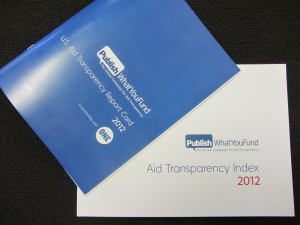U.S. Aid Transparency Report Card 2012
Publish What You Fund and ONE warmly welcomed Secretary Clinton’s announcement in late 2011 that the U.S. was joining the International Aid Transparency Initiative (IATI). Such a commitment added immensely to the Administration’s drive for more open and detailed information about its foreign assistance, particularly on two crucial elements: timeliness and international comparability.
But as Secretary Clinton underscored at the Open Government Partnership (OGP) meeting in April 2012, “[i]t’s not enough to assert that we are committed to openness. We have to deliver on the commitments that we have made.”1 To assist with that implementation process, we have drawn out the findings of the 2012 Aid Transparency Index to explore the state of U.S. aid transparency in detail.
2012 Aid Transparency Index results
The transparency of five U.S. agencies and one program was analyzed. Collectively, they showed a wide variety of performance, ranging from MCC’s “fair” rating to DOD’s “poor” one. Despite the significant spread, no U.S. institution scored in either the “good” (above 80%) or the “very poor” (below 20%) categories.
As a group, the U.S. agencies and PEPFAR received an overall average score of 45%, a little above the average score of 41% for all 72 organizations assessed. However, when compared to other very large donors, such as the World Bank and the European Commission, the U.S. performs relatively poorly.3 While the U.S. has made ambitious commitments that would increase aid transparency, they have not been fulfilled, and the U.S. scores reflect that the U.S. is not a leader on aid transparency. In fact, U.S. organizations occupy five of the bottom seven ranks when comparing the performance of only the very large donors.
The good news is that progress has been made. Some U.S. institutions made significant jumps in their scores, compared to the 2011 Pilot Index. There is, of course, much work to be done, and the 2012 Index and this accompanying paper offer agency-specific recommendations, which we believe will help accelerate that progress and deliver on the tremendous potential of IATI.
Recommendations for U.S. implementation
Recognizing the challenge of having some 26 U.S. agencies involved in the provision of foreign assistance, the U.S. started to tackle aid transparency seriously by launching the Foreign Assistance Dashboard in 2010. Since then, however, progress has been slow, and only three agencies have released limited data. At this point, it appears that aid transparency commitments greatly outrank implementation. The U.S. should lead its international peers on aid transparency, not lag behind them.
While a “whole-of-government” approach makes sense for articulating vision and end goals, it needs to allow for flexibility in implementation, recognizing that different agencies have different models and mandates, thus different ways of collecting information. Nor should U.S. transparency be held up by those agencies lagging behind. Some agencies, such as MCC, or individual bureaus are in a good position to start publishing near real-time information to the common standard (IATI) and should be given the green light to do so. The U.S. should not hold back publication of useful information because some agencies are not yet ready.
Timeliness is the top priority for recipient governments trying to plan their budgets. The Office of Management and Budget should encourage agencies to begin publishing their information directly to the IATI Registry
(in XML), instead of delaying information by channelling through domestic processes. The Foreign Assistance
Dashboard will be an important mechanism for interpreting U.S. aid information as a whole, by aggregating, visualizing and communicating it. Therefore, it should be a key consumer of agencies’ IATI data, not the producer.
We recommend a “publish what you can” approach to test the capability of existing systems to produce high quality, timely information that conforms to IATI. This will help agencies build IATI requirements into internal information management systems, greatly reducing the costs of manual error and multiple reporting and enabling improved accountability to U.S. taxpayers and aid recipients alike. Once all publication is automated via IATI, it will become possible to improve the quality and usefulness of U.S. aid information for all concerned.
Read the whole U.S. Aid Transparency Report Card 2012


